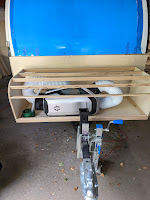As mentioned in an earlier post, I had originally intended to use a small (5000 BTU) window AC to cool
the trailer. This would have been fine - it would have been more than enough air to keep the trailer cool even in an Iowa cornfield, but it was a bit bulky and would have required more than a little creative ductwork. And it would have necessitated what I came to realize was a truly ugly box. As I was debating myself on the merits of this design, I came across another ad for the Zero Breeze Mk II, which was designed for cooling a camper, tent or similar. It's small, very lightweight (about the size of an old canister vacuum, and best of all - it runs on 24vDC. That in itself improves the working efficiency by 15-20% (no need to convert battery to AC). Yep, ordered one and received it in about 10 days. Perfect.
With that in mind, I took a fresh look at 'the box'. I'd never liked the big black box, but it seemed a logical choice due to the space requirements. I decided to design one that followed the lines of the trailer, and was a bit smaller. After carefully measuring the Zero Breeze size, and made the box large enough to hold it and maybe a screen porch. The new box size also means that I can drop the bike rack a few inches lower, which will improve driving - getting them down out more out of the air flow. I was mostly able to use 'scrap' plywood panels to build it. The floor is dominoed together from two pieces of 3/4 BB, and the sides are 1/2¨ BB with oak stringers. I added blocking in the center and along the edges for a little extra surface area.
really not contemplated how much sheer volume is consumed by 4" ductwork! With three ducts emerging from the Zero Breeze, two into the cabin for cold air and return air, and an exhaust vent, they occupy a *lot* of real estate. It's not glamorous, but they got handled and still left enough room for tools. Also, the Zero Breeze has a set of slots on the bottom that conveniently fit a 1/4¨ carriage bolt, so that will get locked down too.
Expect one more post on the AC and tongue box. It's still a work in progress, but I am down to the last bits in prep for a 12 August shakedown run!

















